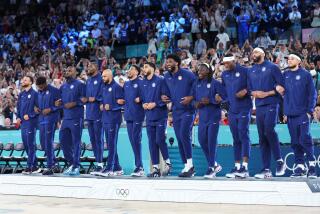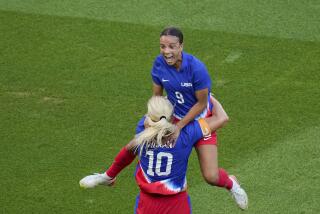It Isn’t a Dream Come True
- Share via
SANTO DOMINGO, Dominican Republic — Tell a star college basketball player he should try out for the next Olympics -- Dream Team, Athens, world spotlight -- and his eyes figure to light up.
Where do I sign up, coach?
Tell that same star a few months back that he should try out for the Pan Am Games -- collegiate teammates usually not ready for the NBA draft, Dominican Republic, little or no TV coverage back home -- and his eyes figure to drop.
Uh, I’ll get back to you, coach.
So it should come as no surprise that the U.S. has not won a gold medal in men’s basketball in the Pan Am Games in 20 years and had to struggle Monday just to get into the medal round of this year’s competition, hanging on for a 74-72 victory over Uruguay.
The U.S. once owned Pan Am men’s basketball, dominating as it almost always did wherever the sport was played on an international level.
Beginning with the inaugural Pan Am Games, held in Buenos Aires in 1951, the U.S. men won the first five Pan Am basketball gold medals in this quadrennial event, going 26-1, their only loss being a stunning 54-53 defeat pulled off by Argentina in Mexico City in 1955. After Brazil broke the streak by winning the gold in Colombia in 1971, the U.S. won the next three to give the Americans eight gold medals in nine Pan Am Games.
That last gold-medal winner, which played at Caracas, Venezuela, in 1983, went 8-0 thanks to such future NBA stars as Sam Perkins, Mark Price and Chris Mullin.
Oh yeah, and a 20-year-old from North Carolina named Michael Jordan.
But ever since then, it has been bleak for the U.S.: a silver medal in 1987 in Indianapolis, a bronze in 1991 in Havana, a silver in 1995 in Mar Del Plata, Argentina, and another silver in 1999 in Winnipeg, Canada.
Such results shouldn’t be shocking since the U.S. doesn’t allow pros on its Pam Am team, while its competitors do, and since the best of the amateur talent leaves college early for the NBA, or, in an ever-increasing trend, doesn’t even get to college, jumping directly from high school to the pros.
“The only country in the world where the word ‘amateur’ exists is the U.S.,” said Sean Ford, assistant executive director of USA Basketball, the governing body for men and women.
“When we played Puerto Rico, they had two pros,” said U.S. men’s head coach and Michigan State Coach Tom Izzo, commenting on Puerto Rico’s 86-85 win over the U.S. on Sunday. “We are still playing the younger kids, and sometimes not even the best younger kids. You’ve got kids leaving early. In our program [at Michigan State], we’ve lost four guys in the last three years and we’re not Duke.
“Plus, you’ve got new academic rules which require some kids to go to summer school. So we’re not getting the cream of the crop.”
Izzo also knows that, after a grueling college season, the Pan Am Games can be anticlimactic. Asked whether most college kids would rather be in the NCAA Final Four or win Pan Am gold, Izzo didn’t hesitate.
“Final Four,” he said.
Further complicating his task, Izzo said, are rules at these Games that limit substitutions and the circumstances under which timeouts can be called.
“We’ve got guys who’ve been together 10 or 11 days,” Izzo said, “playing against guys who may have been playing together in their country all their lives. When you ask our guys to make decisions together on the floor after playing together just two weeks, you see the difference.”
Izzo thinks it’s also a matter of desire.
“Kids in Europe grow up dreaming of playing in the NBA,” he said.
“Kids here don’t dream of going to Europe to play. So players from other countries have more of a sense of urgency. They want to prove something to us.
“It used to be a thrill for our kids to come to something like this. But now, college teams go to Alaska, Hawaii, travel all over the world. It may have been the case 15 to 20 years ago, but now, this is no longer the goal at the end of the rainbow. Kids want to get to the NBA as quickly as they can.”
The goal at the end of the rainbow in the 1987 Pan Am Games for Brazil was to knock off the U.S., which the Brazilians did in the gold-medal game, 120-115.
Jorge Guerra, a guard on that team and now an assistant coach for the Brazilian squad at these Pan Am Games, thinks his team’s upset victory opened the gates for all the others who have triumphed over the U.S. since.
“We felt like it was an impossible mission at the time,” said Guerra through a translator. “But because of the win, it became a reality to all the other countries that the U.S. can be beaten. Everybody can beat the U.S.
“I think it led to them putting professionals on the U.S. team for the Olympics. It changed their attitude.”
The attitude of other Pan Am teams has also changed, according to Price.
“Before, I think there was a fear factor in facing us,” said Price, speaking from Atlanta.
“But now, there are so many foreign players in the NBA, I think that fear factor has kind of been taken away. They are used to playing against us, so they are not intimidated anymore.”
Yet, for all the problems, there is talent on this current U.S. squad, led by center Emeka Okafor of Connecticut, and guard Rickey Paulding and forward Arthur Johnson of Missouri.
“I still think we are talented enough to win here,” Izzo said. “We are not looking for excuses. We just have to get it done.”
How has he gotten this talent here? How has he convinced these players the Pan Am Games are still a worthwhile venture?
“I just tell them,” he said, “ ‘Hey, you looking forward to the NBA? Come here and face these guys on the other teams. They are the ones who are going to be trying to take your jobs.’ ”
More to Read
Go beyond the scoreboard
Get the latest on L.A.'s teams in the daily Sports Report newsletter.
You may occasionally receive promotional content from the Los Angeles Times.






